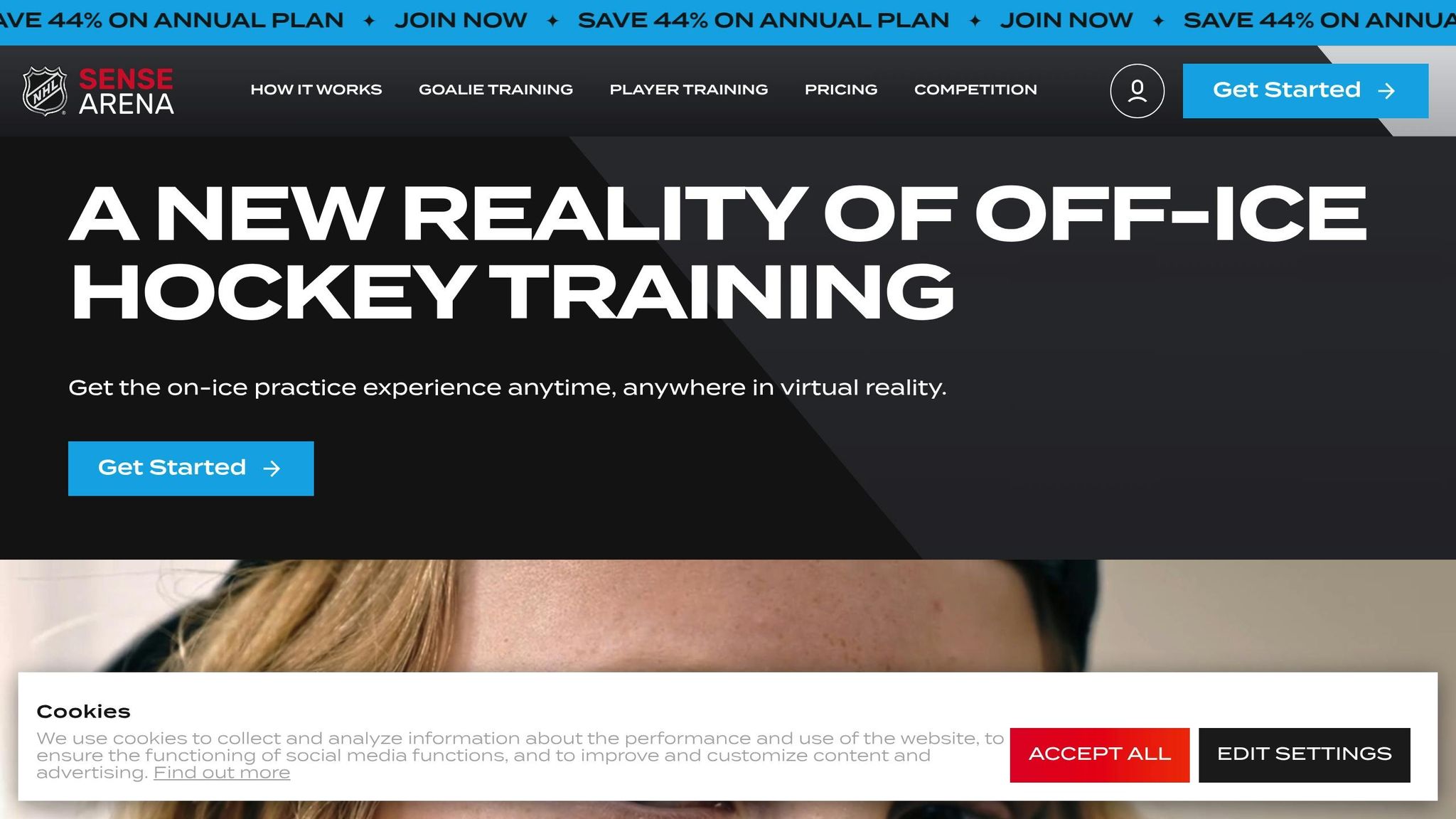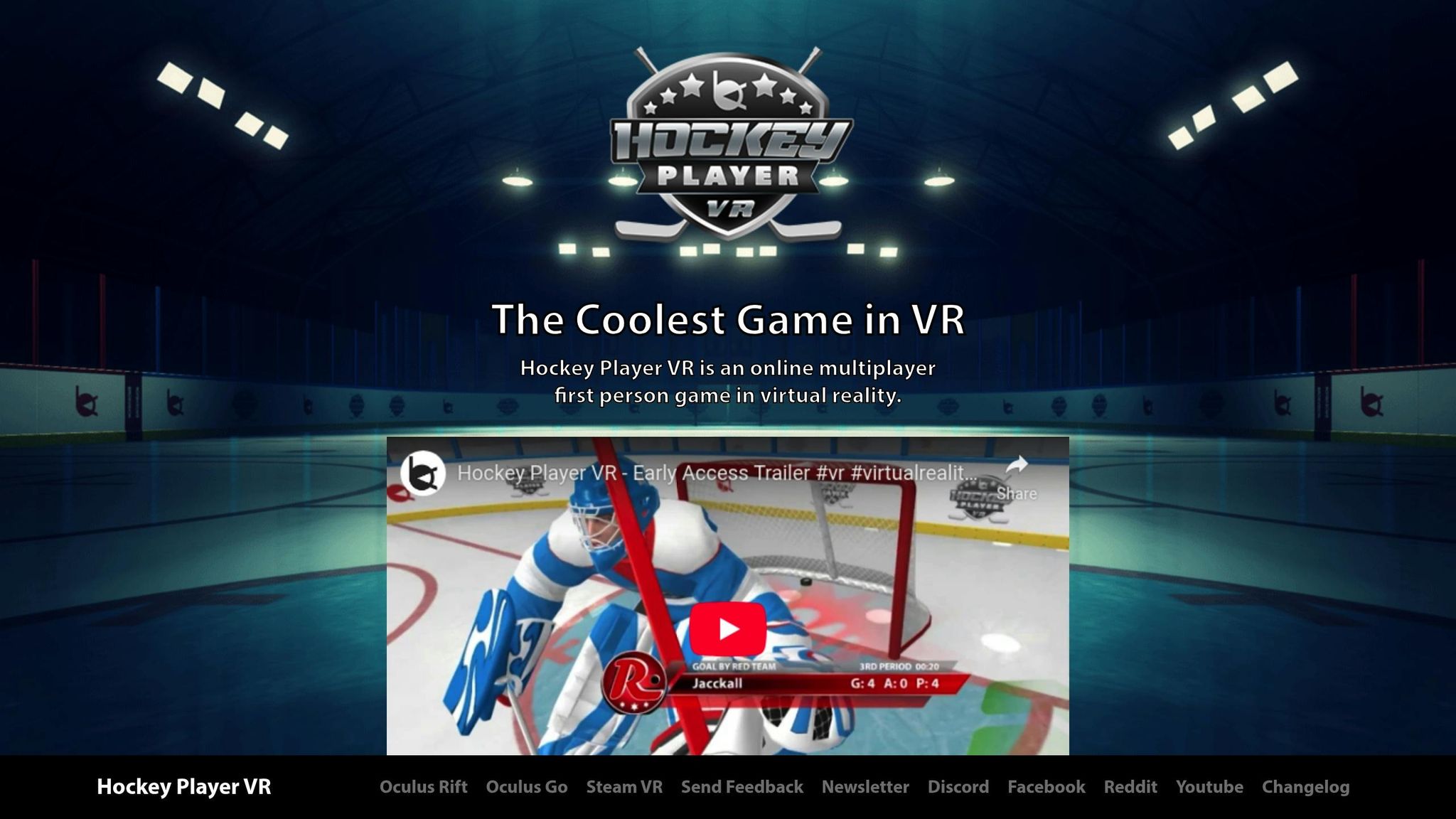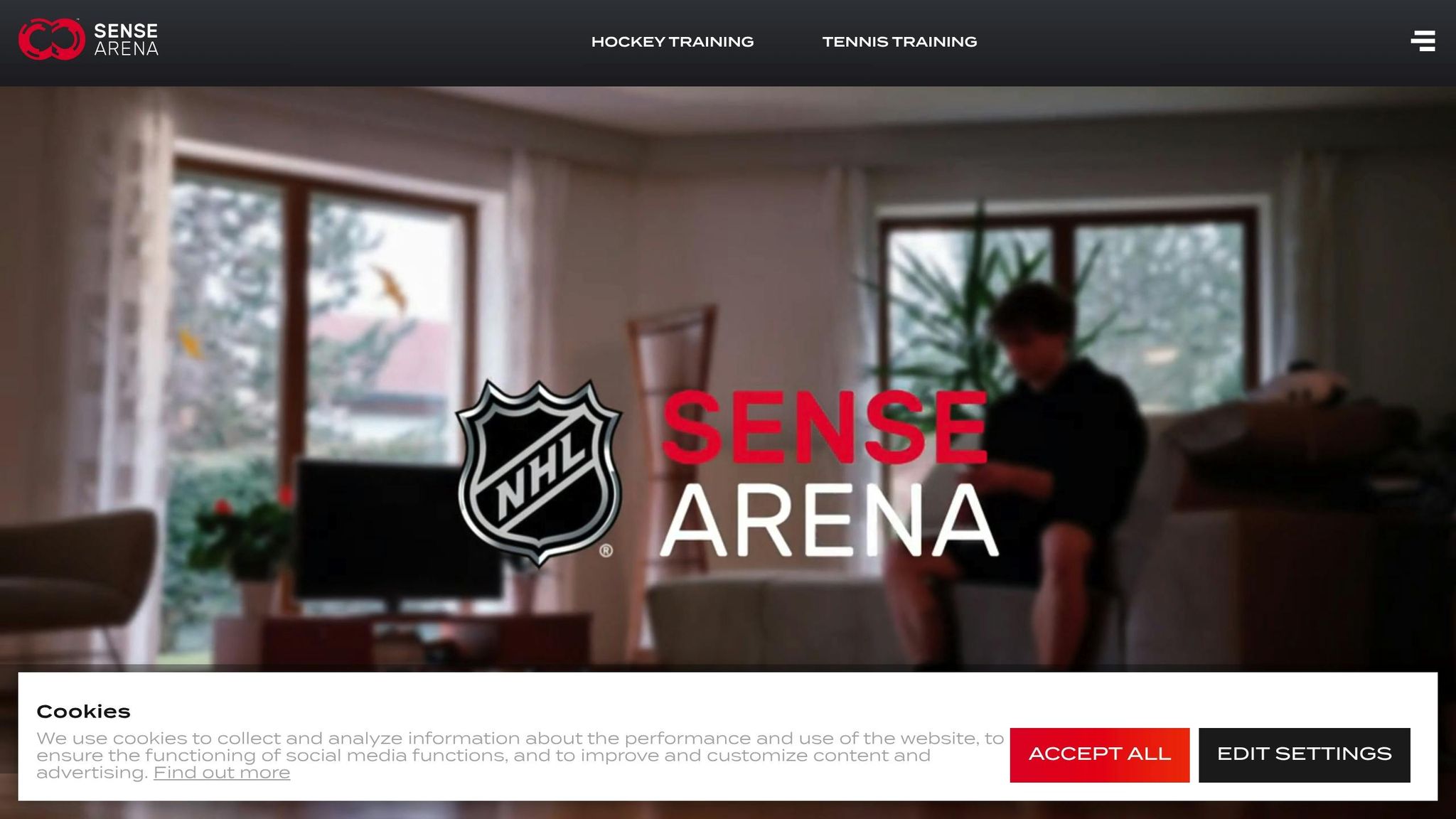Best VR Platforms for Hockey Training
Virtual reality (VR) is transforming hockey training by offering players a way to improve decision-making, reaction speed, and overall hockey IQ without needing ice time. Platforms like NHL Sense Arena and Hockey Player VR simulate real-game scenarios, providing safe, repeatable drills and data-driven feedback. Here's why VR hockey training is gaining traction:
- Faster Skill Development: Players report 10 times more puck touches and a 98% boost in hockey IQ within a month.
- Convenience: Train anywhere - no rink or skates required.
- Injury Recovery: Stay mentally sharp during rehabilitation.
- Pro-Level Results: NHL teams and players see measurable improvements, like a 10.6% increase in goalie save percentage.
Quick Overview of Top Platforms:
- NHL Sense Arena: Trusted by NHL teams; focuses on cognitive and reaction-time training. Requires Meta Quest headset. Costs $33/month (annual plan).
- Hockey Player VR: Emphasizes hand tracking and skill refinement. Compatible with Quest devices.
- Sense Arena VR Ecosystem: Combines physical and mental training for players and institutions.
VR hockey training is reshaping how players practice, making it an efficient, accessible, and results-driven option for all skill levels.
Can VR Hockey Help Improve My Skills? - First Look at NHL Sense Arena 25


Click to watch: Can VR Hockey Help Improve My Skills? - First Look at NHL Sense Arena 25
Key Features of VR Hockey Training Platforms
VR hockey training platforms are designed to cater to players at all skill levels. These systems provide much more than just simulations - they deliver a complete training environment that sharpens both the physical and mental aspects of the game.
Immersive Training Drills
These platforms recreate realistic hockey scenarios, allowing players to practice skills like shooting and stickhandling in a controlled, game-like setting. By mimicking the fast-paced dynamics of a hockey match, players can work on specific techniques in context, helping them build muscle memory without always needing ice time.
VR training also isolates individual elements of the game, enabling players to focus on areas like power play strategies or penalty kill positioning. This targeted approach ensures that players can refine their skills more effectively.
Professional athletes have already embraced these tools. Joe Daccord of the Seattle Kraken shared:
"I use NHL Sense Arena as my pre-game routine and game preparation."
Similarly, Devon Levi from the Buffalo Sabres noted:
"NHL Sense Arena helps keep my mental game sharp in between practice sessions and games."
With unlimited and safe repetitions, players can push their limits without risking injuries. This immersive training integrates seamlessly with data-driven feedback, creating a well-rounded experience.
Real-Time Feedback and Analytics
Building on the foundation of realistic drills, VR systems deliver instant, data-driven feedback to fine-tune performance. These platforms track countless data points every second, giving both players and coaches a clear picture of training progress.
When mistakes occur, VR headsets provide immediate visual and auditory cues, helping players correct errors on the spot. For instance, Hockey Copilot offers real-time shot accuracy feedback, allowing players to see exactly where they need to improve.
The detailed data goes beyond surface-level metrics. As Damian McDoom, a performance coach, explained:
"Love it! The ability to track performance and how it stores data to see exactly what strengths and weaknesses are is wonderful!"
This depth of analysis helps coaches and players make informed decisions about training priorities, ensuring improvements are based on hard data rather than guesswork.
Cognitive and Reaction-Time Training
One of the standout features of VR hockey platforms is their ability to sharpen players' mental game. These tools enhance skills like play anticipation, decision-making speed, and overall Hockey IQ. Personalized feedback pinpoints areas such as missed passes, delayed reactions, or poor positioning, helping players address these issues head-on.
The cognitive training focuses on several critical skills that directly impact on-ice performance:
| Cognitive Skill | Benefit in Hockey |
|---|---|
| Anticipation | Predicts opponent movements for better game planning |
| Mental Flexibility | Adapts quickly to changing game situations |
| Eye-Hand Coordination | Enhances puck handling and shooting precision |
| Inhibition | Reduces impulsive errors and penalties |
| Reaction Time | Speeds up responses to passes, shots, and defensive plays |
Studies have shown that VR training can improve reaction times by up to 27%. Professional players have also reported 9% faster decision-making and 11% better reaction times.
John Schiavo, a professional hockey player, highlighted its benefits:
"I'm really loving the hand-eye coordination training we're getting. Makes me use my brain and hands simultaneously."
Jeff Flaro, CEO of Concept Hockey, further emphasized:
"Reflexion GO is phenomenal! By training cognitive, players are able to process data faster and make better decisions."
Top VR Platforms for Hockey Training
The world of VR hockey training has grown rapidly, offering players new ways to sharpen their skills. From high-end professional simulations to easy-to-use home setups, these platforms cater to a wide range of needs. Here's a closer look at some of the top options, along with their standout features and practical benefits.
NHL Sense Arena
NHL Sense Arena delivers a complete VR hockey training experience, trusted by professional teams and endorsed by USA Hockey. The platform offers drills that mimic real game scenarios, making it a go-to choice for serious players.
You'll need a Meta Quest headset (compatible with Quest 2, 3, 3S, and Pro) and a training space of 6×6 ft for controller use or 12×12 ft for stick training. Optional add-ons like controller mounts and goalie gear enhance the realism.
The pricing is competitive: $33/month with an annual plan (billed at $396) or $59/month for a monthly plan. For those new to VR, bundled options are available, such as the Meta Quest 3S Bundle ($695) or the Meta Quest 3 Bundle ($895), both of which include a one-year subscription.
NHL Sense Arena supports up to 4 user profiles and multiplayer modes for up to 20 participants. Its 3v3 full-ice mode stands out, offering an immersive simulation of actual gameplay. With a 4.0/5 star rating from 895 reviews, users highlight its effectiveness in improving skills, decision-making, and reaction speed.
Hockey Player VR

Hockey Player VR focuses on realistic hand tracking and physics, making it a strong option for players looking to refine their technique. It's compatible with Quest 1, 2, and 3/3S devices, ensuring accessibility across different VR generations.
The platform uses a step-by-step training system, starting with basic drills and progressing to more advanced scenarios. It also includes skill-specific modules that break down complex hockey movements into smaller, manageable steps, helping players build a solid foundation before advancing to high-level gameplay.
Sense Arena VR Ecosystem

The Sense Arena VR Ecosystem takes training further by combining physical skills with mental development and situational learning. It's especially effective for goalies, offering tools to improve depth positioning and angle mastery.
One of its standout features is the ability to teach players how to read shot releases - a skill that's hard to replicate in traditional training. Its scenario-based modules also prepare players for rare but critical game situations, adding an extra layer of readiness.
Comparing Key Features
Here's a quick look at how these platforms stack up:
| Platform Feature | NHL Sense Arena | Hockey Player VR | Sense Arena VR Ecosystem |
|---|---|---|---|
| Hardware Compatibility | Quest 2, 3, 3S, Pro | Quest 1, 2, 3/3S | Multiple VR Systems |
| Target Users | All skill levels | Individual players | Players & institutions |
| Key Strength | Professional drills | Hand tracking & physics | Mental skills training |
Why VR Training Makes Sense
Compared to traditional hockey training methods, VR platforms offer a more affordable and flexible alternative. Training camps can cost over $500 per weekend, and private ice sessions often exceed $300 per month. With VR, players get unlimited practice opportunities, available 24/7, all within a controlled and consistent environment. These platforms are redefining off-ice training by merging cutting-edge technology with practical, cost-effective solutions.
VR Hockey Training Platform Comparison
When deciding on a VR hockey training platform, it's essential to weigh the features, requirements, and costs of each option against your specific training goals. Platforms cater to different skill levels, budgets, and objectives, making it crucial to choose one that aligns with your needs.
Here's a quick breakdown of the key aspects of each platform:
| Feature | NHL Sense Arena | Hockey Player VR | Sense Arena VR Ecosystem |
|---|---|---|---|
| Monthly Cost | $33/month (annual) or $59/month | Not specified | Varies by institution |
| Hardware Required | Meta Quest 2, 3, 3S, Pro | Not specified | Varies by setup |
| Space Requirements | 6×6 ft (with controllers) or 12×12 ft (with stick) | Standard VR space | Varies by installation |
| Target Users | Youth to NHL professionals | Individuals seeking skill development | Players and institutions |
| Primary Focus | Cognitive training and decision-making | Technical skill refinement (aim, puck control, reaction time) | Cognitive and situational training |
Each platform brings unique strengths to the table. For instance, NHL Sense Arena is well-regarded for improving skills and reaction times through consistent use, as reported by users. On the other hand, Hockey Player VR focuses on sharpening technical skills like puck control and reaction time, while the Sense Arena VR Ecosystem emphasizes cognitive and situational training, making it a versatile option for both individuals and institutions.
Training intensity is another standout feature. Bob Tetiva, CEO of Sense Arena, highlights the efficiency of VR training:
"In our VR practise, you do thousands of touches and repetitions, so half an hour in VR would be equivalent to about 2.5 hours practise on ice... amounting to roughly five times more intensity of training."
Professional teams like the New Jersey Devils and Arizona Coyotes have integrated NHL Sense Arena's player and goalie training modules into their official programs, showcasing its credibility at the highest levels of the sport.
Additionally, equipment flexibility varies across platforms. NHL Sense Arena offers optional controller mounts for goalie gloves and hockey sticks to enhance the realism of training sessions. Meanwhile, both Hockey Player VR and the Sense Arena VR Ecosystem allow for adaptable equipment setups tailored to individual or institutional preferences.
Ultimately, selecting the right VR hockey training platform depends on your goals, budget, and whether you're training solo or as part of a team. Each platform offers something distinct to help players elevate their game.
Combining VR with Advanced Off-Ice Training Systems
Bringing VR into the mix with off-ice training tools opens up a new way to develop both mental and physical skills at the same time. This combination creates a well-rounded training approach that pushes players to improve faster and smarter.
Cognitive Skills Meet Physical Development
Virtual reality hones hockey sense and reaction time, while tools like simulators, synthetic ice, and treadmills focus on building muscle memory and refining technical abilities. Together, they create a powerful training dynamic. For example, players using NHL Sense Arena have shown a 9% improvement in decision-making speed and an 11% boost in reaction time on average. USA Hockey acknowledges this, stating:
"Sense Arena's groundbreaking VR technology provides a cutting-edge off-ice tool that is specifically engineered to enhance read-and-react skills and cognitive performance for skaters and goalies."
Boosting Training Intensity and Repetition
Combining VR with physical training ramps up the intensity of practice sessions. Bob Tetiva, CEO of Sense Arena, emphasizes:
"The key benefit is the really high intensity of the training, because you are the center of all the drills."
In VR, players can rack up thousands of touches and repetitions in a short time. Just 30 minutes in VR can equal 2.5 hours of on-ice practice. This makes VR a perfect match for tools like shooting and stickhandling simulators or synthetic ice, where players can focus on specific skills while maintaining a high level of engagement.
Creating a Unified Training System
Advanced systems from places like Hockey Gyms enhance VR training by adding tools like shooting simulators with motion capture and real-time feedback. Synthetic ice helps players fine-tune their skating and puck-handling techniques under realistic conditions. Meanwhile, VR recreates full-ice game scenarios that are hard to replicate in smaller physical spaces. Together, these tools form a seamless training experience, maximizing the benefits of both cognitive and physical development.
The Power of Data-Driven Feedback
These integrated systems also provide detailed performance data. VR platforms analyze decision-making, reaction times, and spatial awareness, while physical training tools measure shot accuracy, puck control, and technical execution. This dual-feedback system gives players and coaches a complete view of performance, making it easier to connect progress in VR training to physical drills.
Rehabilitation and All-In-One Training Solutions
For injured players, VR offers a low-impact way to stay sharp mentally while gradually returning to physical activity. It allows them to maintain their hockey sense during recovery. Pairing VR with advanced off-ice tools - like Hockey Gyms' skating treadmills, which feature motion capture and speeds up to 22 mph - creates a comprehensive training environment. This setup lets players work on skating, shooting, stickhandling, and decision-making in a single session, mimicking the complexity of an actual game.
Conclusion
VR is reshaping hockey training in ways traditional methods simply can't match. Take NHL Sense Arena as an example: players using this platform have shown 9% faster decision-making and 11% better reaction times, while goalies have achieved a 10.6% increase in save percentage and a 10% boost in reaction time. These numbers speak volumes about the impact of VR on both cognitive and physical aspects of the game.
The benefits of VR go beyond just sharpening basic skills. Research reveals that even 15 minutes of VR feedback training can significantly enhance the perceptual abilities of professional ice hockey players. This means better spatial awareness and quicker recognition of scoring opportunities. Roger Grillo, USA Hockey's Director of Player Development, highlights the mental edge VR provides:
"The hardest piece of the game for coaches to coach is the mental side...This tool forces athletes to decide in a safe environment where every decision is a learning opportunity."
When combined with other advanced off-ice tools - like shooting simulators, synthetic ice, and skating treadmills from Hockey Gyms - VR creates a well-rounded training system. This synergy supports both the cognitive and physical development of players, offering a unified approach to performance improvement.
Accessibility is another game-changer. With 98% of users reporting improved hockey IQ and 10 times more puck touches compared to a typical practice session, VR makes high-quality training more engaging and effective. The data-driven feedback it provides ensures players can refine their skills faster and more efficiently.
For players, coaches, and training facilities aiming to stay ahead, VR is no longer optional - it's becoming a necessity. By offering immediate feedback and safe, repeatable practice scenarios, VR platforms are setting the stage for a new era in hockey training, perfectly tailored to meet the demands of the modern game.
FAQs
How can VR platforms enhance hockey IQ and decision-making skills during training?
Virtual reality platforms are changing the way hockey players train by helping them boost their hockey IQ and make quicker, smarter decisions during games. These platforms create lifelike game scenarios, giving players the chance to practice reading plays, enhancing situational awareness, and reacting swiftly to fast-changing situations.
By practicing repeatedly in a controlled virtual setting, players can gain confidence in their decision-making and sharpen their ability to see the ice more effectively. Research shows that regular use of VR training tools can significantly improve reaction times and play-reading skills, which can lead to stronger performances in actual games.
What do I need to set up a VR hockey training system at home?
To create a VR hockey training setup at home, start by ensuring you have enough space. For basic training with controllers, you'll need at least 6x6 feet of clear area. If you plan to use a hockey stick, aim for a larger space - around 12x12 feet. For the most immersive experience, a space between 16x16 feet and 25x25 feet is ideal. Make sure the area is free of obstacles to move around safely.
On the hardware side, you'll need a VR headset like the Meta Quest 2 or 3, along with controllers. If you want to take things up a notch, consider adding hockey stick mounts for a more realistic feel. Keep in mind, you'll need about 1.35 GB of storage for the system and software.
With these essentials in place, you can turn your home into a cutting-edge hockey training zone, letting you practice and improve your skills in a virtual environment.
How can VR training work with off-ice tools to improve hockey skills?
Virtual reality (VR) training adds a new dimension to off-ice hockey preparation by creating immersive environments where players can sharpen essential skills like quick decision-making, reaction time, and mental focus. When paired with physical tools like shooting simulators or stickhandling systems, VR allows athletes to replicate game situations and practice in conditions that feel remarkably close to the real thing.
This combination not only helps players fine-tune their abilities but also plays a crucial role in injury recovery. It enables athletes to maintain their edge even when they're unable to hit the ice. Plus, with advanced feedback systems and data tracking, VR training provides a comprehensive way to boost performance, both during recovery and in regular practice sessions.
